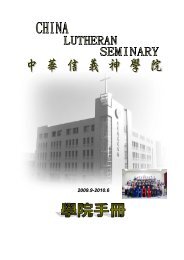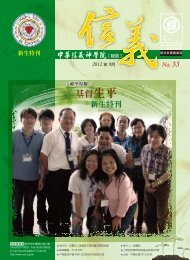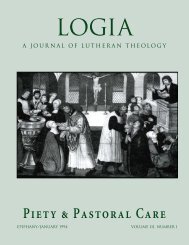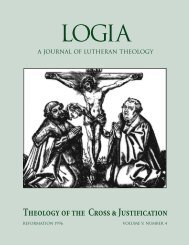04-2 Hermeneutics.pdf
04-2 Hermeneutics.pdf
04-2 Hermeneutics.pdf
- No tags were found...
Create successful ePaper yourself
Turn your PDF publications into a flip-book with our unique Google optimized e-Paper software.
LOGIA FORUM 75sight of God, for all have fallen short in sinfulness [sic] and allreceive the promises of forgiveness” (p 42). Based on this statement,it is asserted: “We cannot believe—because God has notsaid! that our Maker views daughters differently than sons” (p. 42).The doctrine of baptism is called upon to bolster the argument.“How are we to respond to our baptism and to the commissionto go and teach?” asks the essayist (p. 42). She chafes atMissouri’s “traditional answer . . . that, depending on our physicalshape, the church must ascertain which channels are theappropriate ones” (p 42). Mrs. Nuechterlein maintains that“there is nothing in the baptismal covenant suggesting such aproviso: at the font we don’t separate infants into boy and girlcategories” (p. 42).This way of speaking is echoed in the opening paragraph ofthe CTCR’s latest opinion, “The Service of Women in Congregationaland Synodical Offices” (Reporter, December 1994, vol. 20 no.12, p. 8). Therein we find it stated that “No one is baptized to beeither man or woman.” What can be the point here? Humanscome in two distinct genders, male and female. Both are baptizedand by God’s grace grow into Christian men and women respectively.Baptism does not neuter God’s good creation. Baptism doeswash fallen humans clean from sin. Surely our sexuality isredeemed, not obliterated. In its disregard toward the sexualhuman bodies that are God’s own handiwork, the language of Mrs.Nuechterlein and the CTCR smacks of Gnosticism. If Missourianswant their synod to turn into a cult served by priestesses, allowingthis kind of language is a good first step.Yet a little later in her Forum article comes the complaint that“many clergymen get little training for shepherding the ewes of theflock, assuming, apparently, that what’s good for the rams is goodenough for all. It is not” (p 42).First, females ought not to be distinguished from males in thechurch. Then, females require special pastoral care, in sharp distinctionfrom care appropriate for males. The illogic is evident. Ifewes must be treated differently than rams, then Mrs. Nuechterlein’sargument from baptism does not hold water.The Catechism is useful in addressing another concern fromMrs. Neuchterlein’s “Perspective.” The complaint is made that“Christendom continues to be experienced as primarily a man’srealm” (p. 42). It is considered a problem that “this church is . . . amale-dominated body” (p. 42), but: Jesus Christus Dominus est.The Lord rules his church. For Christians who take the SecondArticle of the Creed to heart, this is not a problem. This is a sourceof joy. The rule of the Church by Jesus Christ, true God and trueman, is also a source of hope. Members of the Church Militantlong for the Bridegroom’s complete domination of his Bride whenhe comes again at the Last Day (Eph 5:25–27, Rev 21:2–4).Mrs. Nuechterlein’s “Perspective on Women in Missouri” callsfor study and discussion of the issue of women’s service in thechurch. For years, other women who share her views have beencalling for the same thing. Their statements have received a gooddeal of response from Missouri’s clergy and laity. Yet these womendo not seem to have heeded any respondents who differ withthem. One is left to wonder what their continued call for discussionmeans.Kathryn A. HillMonroe, WisconsinPENANCE FOR RETURNING WARRIORS“Not a few modern philosophers and theologians are of the view that,contrary to implications of Nietzsche’s aesthetic rebellion, even fullyautonomous individuals have reasons of the mind and heart to experiencemoral pain occasionally of their behavior in time of war,” saysBernard J. Verkamp in The Moral Treatment of Returning Warriorsin Early Medieval and Modern Times (Scranton: University ofScranton Press, 1993). The portion cited below comes from pages 11–12of his introduction to this stimulating documentary and discussion.The Western world, as Philip Rieff has noted, has largelybecome a “therapeutic” society. In the name of “authenticity” and“individualistic creativity,” many restrictions of old have been discarded.What were once described as wrongdoings and shortcomingsare now often extolled as indicative of a liberated ego or dismissedas sickness and social maladjustment. Moral pain or feelingsof guilt and shame, which were once considered the natural,interior complements of virtuous behavior, are either ridiculed, orreduced to “psychic difficulties.”In sharp contrast to such a therapeutically oriented society isone in which there prevails a moral sensibility based upon acceptanceand interiorization of a set of principles and ideals derivedfrom a uniquely religious teleology. Nowhere, probably, has thisbeen more apparent than in the way soldiers returning from warhave been treated by contemporary American and early medievalChristian society, respectively.The moral needs of soldiers returning from Vietnam, forexample, were often overlooked by American society. Unable,apparently, to face up to its own failure to win the war, or to admitits own complicity in a war that may have been unwise or unjustand an occasion for unprecedented atrocities, the country as awhole simply chose not to take seriously the moral pain felt bymany of the Vietnam veterans.In contrast, the Christian community of the first millenniumgenerally assumed that warriors returning from battle would orshould be feeling guilty and ashamed for all the wartime killingthey had done. Far from having such feelings dismissed as insignificantor irrelevant, returning warriors were encouraged to seek resolutionof them through rituals of purification, expiation, and reconciliation.To accommodate these latter needs, religious authoritiesof the period not infrequently imposed various and sundrypenances on returning warriors, depending on the kind of warthey had been engaged in, the number of their killings, and theintention with which they had been carried out.The existence of such an early medieval penitential practiceregarding returning warriors has long been recognized by historians.No claim of originality is being made, therefore, for the documentationof its development in the first chapter of this book. Pastreferences to the practice, however, have generally been rather cursoryand piecemeal, and it is to be hoped that the chronologicaland more detailed presentation here will better illustrate the natureand extent of the practice. [Note: subsequent chapters deal withthe underlying rationale of such practices, their demise, and possibleapplications to our modern era. At one point, Verkamp cites aLutheran Vietnam veteran who speaks of the healing he found inthe Lutheran liturgy!—ed.]
















